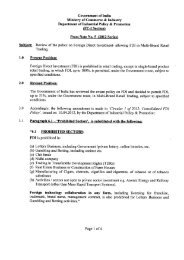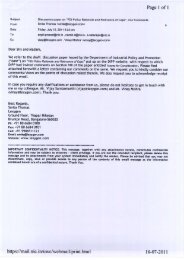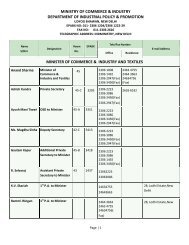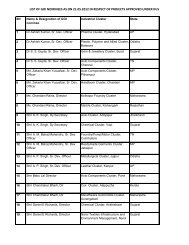fdi in india and its growth linkages - Department Of Industrial Policy ...
fdi in india and its growth linkages - Department Of Industrial Policy ...
fdi in india and its growth linkages - Department Of Industrial Policy ...
You also want an ePaper? Increase the reach of your titles
YUMPU automatically turns print PDFs into web optimized ePapers that Google loves.
FDI IN INDIA AND ITS GROWTH LINKAGES<br />
Market capitalisation is significant <strong>in</strong> Karnataka (11 per cent), Haryana (9 per cent), Gujarat (6.4 per cent) <strong>and</strong> Tamil<br />
Nadu (5.5 per cent). The share of small cities <strong>in</strong> state-level market capitalisation is 14.4 per cent <strong>in</strong> Karnataka, 86.4 per<br />
cent <strong>in</strong> Haryana, 45 per cent <strong>in</strong> Gujarat <strong>and</strong> 44 per cent <strong>in</strong> Tamil Nadu.<br />
The share of net fixed capital <strong>in</strong> total net fixed capital is 11 per cent each <strong>in</strong> Gujarat <strong>and</strong> Tamil Nadu, 10 per cent <strong>in</strong><br />
Andhra Pradesh <strong>and</strong> 8 per cent <strong>in</strong> Haryana. Other states have lower shares. The share of small cities <strong>in</strong> state-level net<br />
fixed capital is 30 per cent <strong>in</strong> Gujarat, 45 per cent <strong>in</strong> Tamil Nadu, 25 per cent <strong>in</strong> Andhra Pradesh <strong>and</strong> 94 per cent<br />
<strong>in</strong> Haryana.<br />
In the case of total output, significant contributions are made by the states, namely, Tamil Nadu (16 per cent), Haryana<br />
(11 per cent), Karnataka <strong>and</strong> Gujarat (each 8 per cent), along with the share of small cities <strong>in</strong> state-level output of 46,<br />
90, 28 <strong>and</strong> 44 per cent, respectively.<br />
6.5 Agglomeration <strong>and</strong> Locational Choice<br />
In this section we focus on agglomeration <strong>and</strong> locational choice of <strong>in</strong>dustrial plants <strong>in</strong> India. While such analysis is<br />
available <strong>in</strong> the literature with reference to the overall <strong>in</strong>dustrial location, a correspond<strong>in</strong>g analysis of FDI-enabled<br />
<strong>in</strong>dustrial plants is scarce. While many <strong>in</strong>dustries tend to be agglomerated <strong>in</strong> a few states/regions others have wider<br />
dispersal. We have discussed the issue of <strong>in</strong>dustrial agglomeration of FDI-enabled plants <strong>in</strong> India aga<strong>in</strong>st the backdrop<br />
of overall <strong>in</strong>dustrial agglomeration. We have also provided analytical <strong>in</strong>formation on the locational choice of FDIenabled<br />
<strong>in</strong>dustrial plants <strong>in</strong> the country.<br />
The measure of agglomeration used <strong>in</strong> our analysis is similar to the one used by Ellison <strong>and</strong> Glaeser (1997) <strong>and</strong> Kathuria<br />
(2009). The determ<strong>in</strong>ants of locational choice of <strong>in</strong>dustrial plants have also been worked out us<strong>in</strong>g econometric<br />
estimation techniques. While agglomeration estimates have been based on state-level data, the determ<strong>in</strong>ants of<br />
locational choice are analysed at the state level as well as at the city level. Apart from this, we have discussed variations<br />
across geographical regions like north, east, west <strong>and</strong> south.<br />
6.5.1 Agglomeration<br />
One important concern <strong>in</strong> India’s <strong>in</strong>dustrial policy is the dispersal of <strong>in</strong>dustrial plants across various states of the country.<br />
There are two types of agglomeration forces, viz., natural advantage <strong>and</strong> spill-overs. Natural advantage refers to factors<br />
of production that provide enabl<strong>in</strong>g conditions for produc<strong>in</strong>g certa<strong>in</strong> goods, e.g., tea, w<strong>in</strong>e, photographic films, etc.<br />
Locational spillovers refer to physical as well as <strong>in</strong>tellectual spillovers, e.g., the brass <strong>in</strong>dustry <strong>in</strong> Moradabad, sports goods<br />
<strong>in</strong>dustry <strong>in</strong> Jal<strong>and</strong>har, hosiery <strong>in</strong> Ludhiana <strong>and</strong> software <strong>in</strong> Hyderabad <strong>and</strong> Bangalore.<br />
We use the Ellison-Glaeser (E-G) <strong>in</strong>dex to calculate the degree of <strong>in</strong>dustrial (NIC 3-digit) agglomeration/dispersal<br />
across various states/Union Territories of India. 14 The <strong>in</strong>dex is computed us<strong>in</strong>g employment <strong>and</strong> output <strong>in</strong>formation for<br />
all plants, both domestic <strong>and</strong> FDI. This <strong>in</strong>dex controls for <strong>in</strong>dustry characteristics regardless of the causes of<br />
concentration. The E-G <strong>in</strong>dex can be estimated either by us<strong>in</strong>g concentration of output of <strong>in</strong>dustrial plants or us<strong>in</strong>g<br />
concentration of employment data. While the E-G <strong>in</strong>dex derived from the employment data, E-G-L, attributes<br />
<strong>in</strong>dustrial agglomeration solely to labour market pool<strong>in</strong>g <strong>and</strong> <strong>in</strong>formation of spill-overs through labour, the same cannot<br />
be said of the <strong>in</strong>dex derived us<strong>in</strong>g the output data (E-G-O). In this study, the agglomeration <strong>in</strong>dex has been computed<br />
us<strong>in</strong>g the value of output attributes agglomeration to labour market as well as capital/technology spill-overs or a<br />
comb<strong>in</strong>ation. However, geographical concentration by <strong>its</strong>elf does not imply the existence of spill-overs or natural<br />
advantage <strong>in</strong>dicators.<br />
14.For details of the E-G <strong>in</strong>dex, refer to Ellison <strong>and</strong> Glaeser (1997). The <strong>in</strong>dex varies between 0 <strong>and</strong> 1. An E-G <strong>in</strong>dex above 0.05 for an <strong>in</strong>dustry connotes<br />
high agglomeration, between 0.02 <strong>and</strong> 0.05 is moderate agglomeration, <strong>and</strong> between 0 <strong>and</strong> 0.02 a dispersed <strong>in</strong>dustry. E-G values less than 0 for a sector<br />
<strong>in</strong>dicate excessive dispersion.<br />
68












